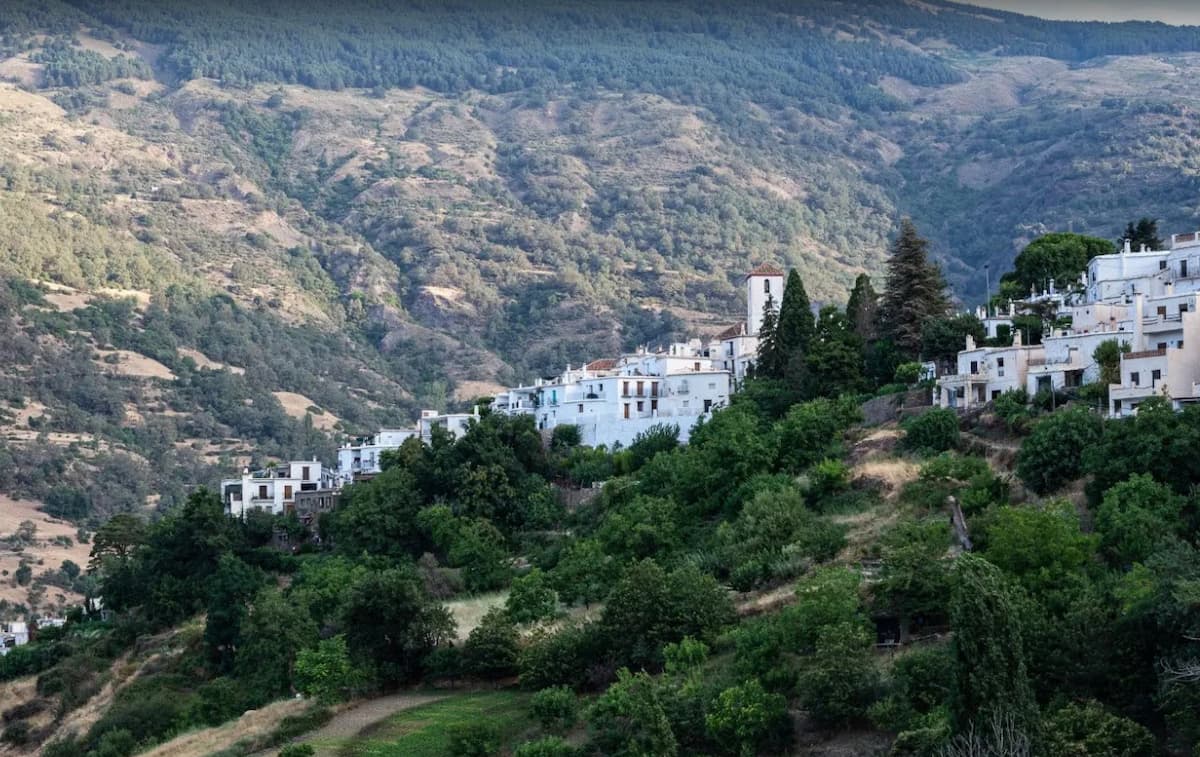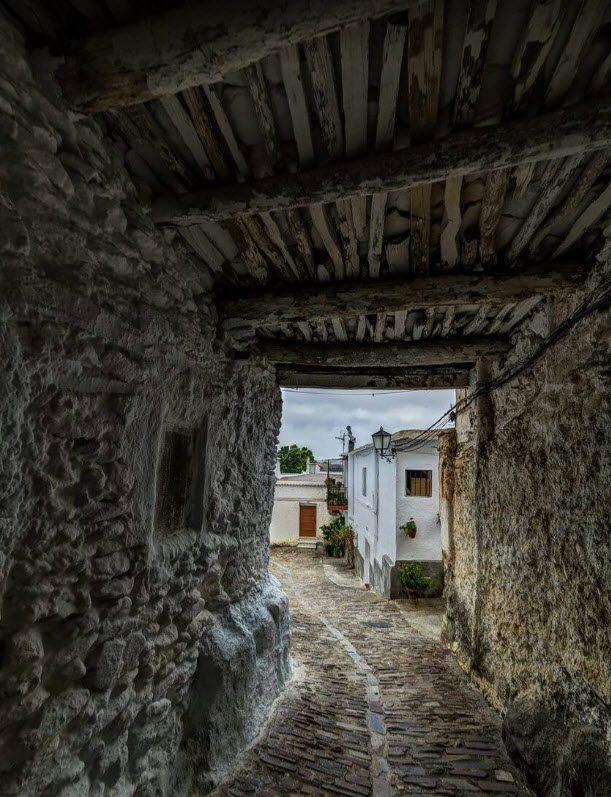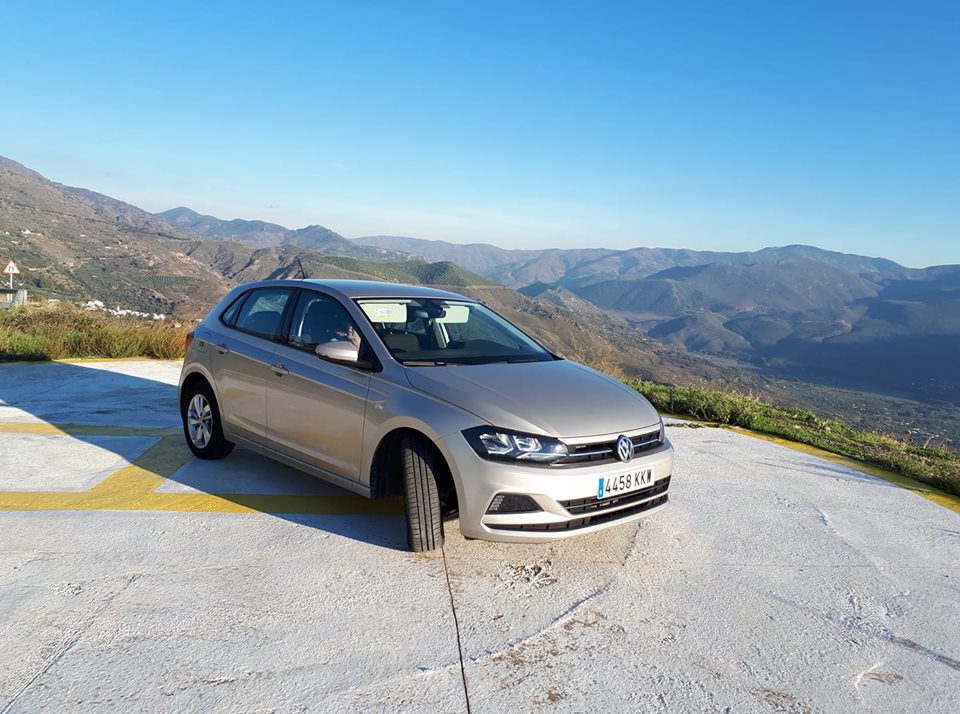
Come with us to the most beautiful white villages of the Alpujarra Granadina. Immerse yourself in breath-taking landscapes of high mountains and valleys with microclimate.
Clean air, and crystal-clear water from Sierra Nevada everywhere. Moorish heritage palpable in every corner. Excellent gastronomy. Lots of handicrafts.
A place where time stands still.
Table of Contents
Why visit the Alpujarra (from Malaga)
As we drive along the winding roads between high hillsides, pine forests and sun-drenched valleys, we begin to understand why the Alpujarra was the last Moorish stronghold on the peninsula.
Even today it is not a tourist destination that is easy or quick to reach. That said, although it is possible to get to the Alpujarra by bus, we strongly advise against it as it is an odyssey of endless curves and hours of travel.
Going in your MalagaCar is the best way to enjoy the places at your own pace. By car from Malaga you can calculate about 90 minutes to get to Órgiva.

Although it is possible to make a day trip, we recommend staying at least one night to really be in the place and let yourself be enveloped by its magic.
Below we have prepared an interactive map with all the places we are going to introduce you to.
The most beautiful White Villages of the Alpujarra Granadina
Lanjarón and its springs

Lanjarón is the gateway to the Alpujarra coming from Granada. Situated 650 metres above sea level, this village is best known for its spring water, which is also bottled.
It is home to one of Spain’s best-rated spas, with excellent medicinal waters.

Of all the villages in the Alpujarra, it is the most touristic, with a good infrastructure of hotels and restaurants.
In fact, Lanjarón is a good destination in itself for a relaxing weekend of wellness or active tourism, without necessarily going further into the Alpujarra.
In these links you can find more information about hiking trails. Or take a stroll through its charming streets and squares, discover the enormous cultural heritage and let yourself be seduced
by the tasty local cuisine. And last but not least, get yourself a typical wickerwork souvenir.
Órgiva, Spain’s most hippie town

Órgiva is also known as the Ibiza of the south, as outside of this island, it is the municipality with the most alternative life in the whole of Spain.
Although Lanjarón is the “official entrance” to the Alpujarra from Granada, Órgiva is undoubtedly the heart of the whole region and the capital of the Alpujarra.
Arriving on the A-44 motorway from Malaga, we enter the Alpujarra from the south. We already taste the first winding road that goes along the slopes of the Contraviesa mountains, until we arrive after about 15 km in Órgiva, situated like a white jewel in the valley of the river Guadalfeo.

As mentioned, due to its rich alternative life, Órgiva is a very cosmopolitan and bohemian city where many nationalities live.
Here are links to a Facebook group of Alternative Órgiva, Vegetarian Restaurant and organic shop. Or do you fancy a retreat?
If you decide to make Órgiva your “base camp” to explore the surroundings, in this link you find rural houses in Órgiva.
Soportújar, the haunted village
If for some reason you don’t prefer to spend Halloween in Malaga, but in the Alpujarra, here we have the ideal alternative for you:
A whole village dedicated to spooky decoration. And what’s more, all year round!
Not only in the village, but also in the surrounding area there are a few magical things to see, such as a time capsule, magic cauldrons, the witches’ fountain or the wishing well.
And if you’re hungry after all that scaring and walking, drop in at the Buddha’s tavern bar, with vegetarian options!
Pampaneira

The first village of the great Alpujarra “tourist triumvirate”: Pampaneira, Bubión and Capileira, the most visited villages of the Alpujarra, at more than a thousand metres above sea level.
The whole area is noted for its enormous wealth of springs, some of which are mineral-medicinal, and its great variety of handicrafts, especially ceramics and textiles such as the typical colourful Jarapa carpets.

Pampaneira is another excellent base camp for excursions to the nearby villages, the Barranco de Poqueira or the Buddhist centre O Sel Ing.
- In this link you can find accommodation in Pampaneira as well as bars and restaurants.
Bubión

With just over 300 inhabitants, this hillside village between Pampaneira and Capileira is perhaps the most suitable if you are into a “slow destination“, as here almost literally stops the clock (unless you go further into the Alpujarra where it stops altogether).
- Here you find hiking routes and accommodation as well as bars and restaurants.
Capileira

Situated at a respectable altitude of 1,450 metres above sea level on the slopes of the Barranco de Poqueira, this charming village offers stunning views as a natural vantage point.
And it even snows in winter.

It is on the list of the most beautiful villages in Spain.
- At this link you find accommodation, bars and restaurants and more interesting things to do.

Pitres, pure Moorish essence

As we drive further along the winding roads, the villages seem more and more as if they haven’t changed for centuries. Narrow alleys partly covered with large wooden beams, whitewashed houses with walls more than half a metre width…
Arriving in Pitres, at 1,295 metres above sea level, our watch stops completely.
In addition to its charming Moorish past, this village stands out for its enormous wealth of natural and medicinal springs (ferruginous water). The area, called La Tahá, has countless small paths that have linked the villages together for centuries.

Here we leave you a lovely route to a natural waterfall, the Chorreón de Pitres.
And if you want to stay there to forget about the world, you can find in the following link accommodation in Pitres and the villages of La Tahá.
Trevélez and its ham

Trevélez is one of the highest villages in Spain. The village stretches along the southern slope from 1,480 metres to 1,600 metres above sea level.
Due to this location, a large number of hiking routes leave from here to the high Sierra Nevada, like Siete Lagunas, Mulhacén, pico Peñabón and Piedra Ventana, among others.
But Trévelez is also known above all for a unique delicacy: its ham, produced in the traditional artisan way and cured in this clean, fresh air.
If you would like to stay for a few days in this unique environment, here is a link to accommodation in Trevélez.
Curious places of the Alpujarra
Beneficio, the Hippie community
Beneficio is hidden in the mountains in the direction of Cañar.
Depending on the season, up to several hundred people live here without electricity or running water.

Age Of The Aquelarres, Open Air Museum
On the outskirts of Soportujar, this viewpoint with excellent views is dedicated to the theme of witches with small sculptures all around.
Hermitage Padre Eterno

This charming little hermitage is located next to the road between Soportújar and Pampaneira. We can make a stop there and contemplate the marvellous views.
This stop is also interesting for other reasons. From here the forest path leads to the Barranco de Poqueira and the Buddhist retreat centre O Sel Ing.
O Sel Ing Buddhist Centre

In our article about Buddhist centres in Malaga we have also included the very interesting history of O Sel Ing.
O Sel Ing means “place of clear light” and was the name given to the place by the Dalai Lama during his visit in 1982.

As it is a retreat centre, it has public visiting hours.
You can go up either by car or on foot, although we recommend walking up to enjoy the experience more. Always bring a hat, sun protection and plenty of water.
- Visiting hours and more info here.












;) Rural Tourism in Malaga
Rural Tourism in Malaga;) Discover the 11 most beautiful villages of the Axarquia
Discover the 11 most beautiful villages of the Axarquia;) Road Trip from Malaga to Cadiz – The Light Coast
Road Trip from Malaga to Cadiz – The Light Coast